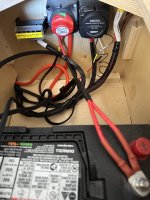Foxen
New member
Hello,
My sister bought a small camper van from a California based manufacturer of van camper interiors. This was their demo vehicle they used for marketing. It was completely built out.
I am helping her with adding solar to the van and got to looking at the 12V wiring the company had done. I "assumed" the fuse block with. the yellow label was all the 12V accessory "positive" wires and on the far right they stacked all the "negative" accessory wiring.
However, looking closer, it appears they stacked all the positive wires (shown on the right) because it looks like a larger gauge RED wire (maybe 6 gauge) is stacked along with these accessory wires. The fuse block doesn't appear to have any positive 12V DC power going to it.
Am I missing something? I plan on digging into it but the van is a few hundred miles from me and time is limited. I know that it can have the neg. wires at the fuse block and work but it is not how I wire our vans. Just wondered what others thoughts are. Appreciate any comments.
Thank you,
Jon

My sister bought a small camper van from a California based manufacturer of van camper interiors. This was their demo vehicle they used for marketing. It was completely built out.
I am helping her with adding solar to the van and got to looking at the 12V wiring the company had done. I "assumed" the fuse block with. the yellow label was all the 12V accessory "positive" wires and on the far right they stacked all the "negative" accessory wiring.
However, looking closer, it appears they stacked all the positive wires (shown on the right) because it looks like a larger gauge RED wire (maybe 6 gauge) is stacked along with these accessory wires. The fuse block doesn't appear to have any positive 12V DC power going to it.
Am I missing something? I plan on digging into it but the van is a few hundred miles from me and time is limited. I know that it can have the neg. wires at the fuse block and work but it is not how I wire our vans. Just wondered what others thoughts are. Appreciate any comments.
Thank you,
Jon

